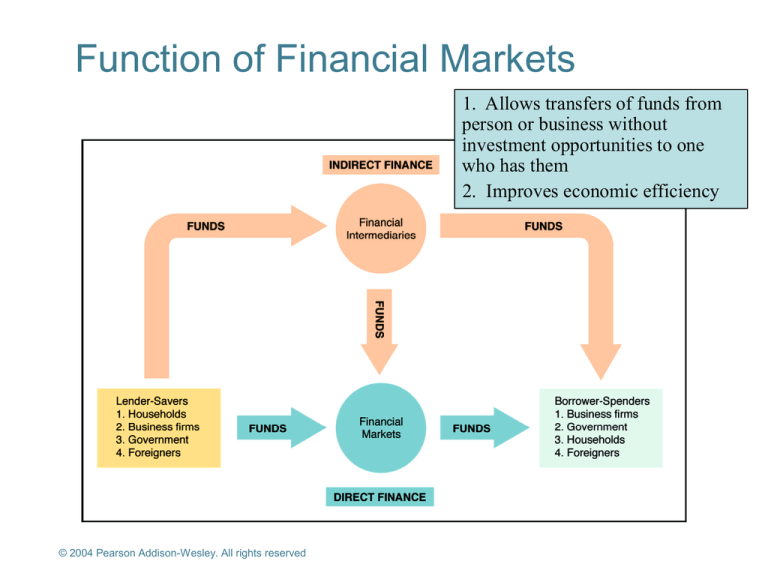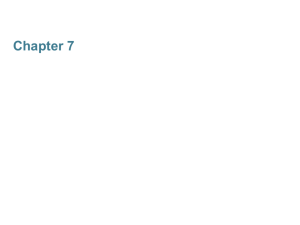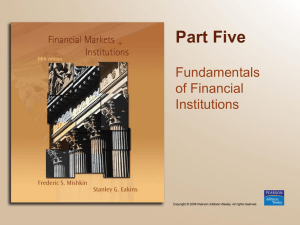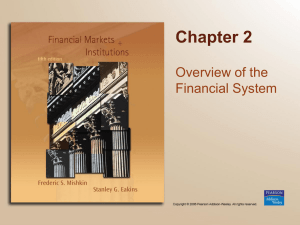
Function of Financial Markets
1. Allows transfers of funds from
person or business without
investment opportunities to one
who has them
2. Improves economic efficiency
© 2004 Pearson Addison-Wesley. All rights reserved
2-1
Function of Financial Markets
• Allocation of funds to productive opportunities.
• Transfer of funds over life horizon.
• Empirical Evidence I: King and Levin (1993) find
that the relative size of financial sector is
positively related to growth.
• Empirical Evidence II: Galindo, Schiantarelli and
Weiss (2002) find that financial liberalizations are
followed by improved capital allocations.
© 2004 Pearson Addison-Wesley. All rights reserved
2-2
Classifications of Financial Markets I
By Financial Instruments
1. Debt Markets
Short-term (maturity < 1 year)
Long-term (maturity > 10 year)
2. Equity Markets
Common stocks (owner a residual claimant)
The value of debt instruments was $20 trillion in
2002 while the value of equity was $11 trillion.
© 2004 Pearson Addison-Wesley. All rights reserved
2-3
Classifications of Financial Markets II
•
1. Primary Market (often behind closed doors)
New security issues sold to initial buyers
•
2. Secondary Market
Securities previously issued are bought and sold
•
•
•
Investment Bank.
Role of Brokers and Dealers.
Liquidity and Valuation Provided by the
Secondary Market.
© 2004 Pearson Addison-Wesley. All rights reserved
2-4
Classifications of Financial Markets III
By Organization of Secondary Market
• 1. Exchanges
Trades conducted in central locations (NYSE,ASE)
• 2. Over-the-Counter (OTC) Markets
Dealers at different locations buy and sell
• U.S. Gov’t Bond Market Organized as an OTC
market with 40 or so dealers.
© 2004 Pearson Addison-Wesley. All rights reserved
2-5
Classifications of Financial Markets IV
By Maturity
1. Money Market (< 1 year debt instruments)
2. Capital Market (longer term debt and equity)
.
© 2004 Pearson Addison-Wesley. All rights reserved
2-6
Internationalization of Financial Markets
International Bond Market
1. Foreign bonds
2. Eurobonds
Now larger than U.S. corporate bond market
World Stock Markets
U.S. stock markets are no longer always the
largest: Japan sometimes larger
© 2004 Pearson Addison-Wesley. All rights reserved
2-7
Function of Financial Intermediaries
Financial Intermediaries
1. Engage in process of indirect finance
2. More important source of finance than securities
markets
3. Needed because of transactions costs and
asymmetric information
© 2004 Pearson Addison-Wesley. All rights reserved
2-8
Transactions Costs
•
•
•
Transaction costs, the time and money spent in
carrying out financial transactions.
Financial intermediaries make profits by
reducing transactions costs
Reduce transactions costs by developing
expertise and taking advantage of economies of
scale
© 2004 Pearson Addison-Wesley. All rights reserved
2-9
Function of Financial Intermediaries
Risk Sharing
1. Create and sell assets with low risk characteristics
and then use the funds to buy assets with more risk
(also called asset transformation).
2. Also lower risk by helping people to diversify
portfolios
© 2004 Pearson Addison-Wesley. All rights reserved
2-10
Asymmetric Information:
Adverse Selection,and Moral Hazard
Adverse Selection (hidden information)
1. Before transaction occurs
2. Potential borrowers most likely to produce adverse
outcomes are ones most likely to seek loans and be
selected
Moral Hazard (hidden action)
1. After transaction occurs
2. Hazard that borrower has incentives to engage in
undesirable (immoral) activities making it more likely that
won’t pay loan back
Financial intermediaries reduce adverse selection and
moral hazard problems, enabling them to make profits
© 2004 Pearson Addison-Wesley. All rights reserved
2-11
Financial Intermediaries
• Depository Institutions (banks) accept deposits
from individuals and institutions and make loans.
• Contractual savings institutions acquire funds at
periodic intervals on a contractual basis. (liquidity
not as important issue as banks.)
• Investment Intermediaries.
© 2004 Pearson Addison-Wesley. All rights reserved
2-12
Financial Intermediaries
2-13
Size of Financial Intermediaries
© 2004 Pearson Addison-Wesley. All rights reserved
2-14
Methods to Ensure Soundness
1.
2.
3.
4.
5.
6.
Restrictions on entry
Disclosure
Restrictions on assets and liabilities
Deposit Insurance
Limits on Competition
Restrictions on Interest rates
© 2004 Pearson Addison-Wesley. All rights reserved
2-15
Regulatory Agencies
2-16
Regulatory Agencies
2-17
Regulation of Financial Markets
Two Main Reasons for Regulation
1. Increase information to investors
A. Decreases adverse selection and moral hazard
problems
B. SEC forces corporations to disclose information
2. Ensuring the soundness of financial
intermediaries
A. Prevents financial panics
B. Chartering, reporting requirements, restrictions on
assets and activities, deposit insurance, and anticompetitive measures
© 2004 Pearson Addison-Wesley. All rights reserved
2-18











